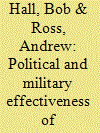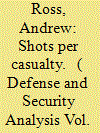| Srl | Item |
| 1 |
ID:
089296


|
|
|
| 2 |
ID:
071891


|
|
|
|
|
| Publication |
New York, PAntheon books, 2006.
|
| Description |
xi, 306p.
|
| Standard Number |
037542363X
|
|
|
|
|
|
|
|
|
|
|
|
Copies: C:1/I:0,R:0,Q:0
Circulation
| Accession# | Call# | Current Location | Status | Policy | Location |
| 051278 | 331.792095113/ROS 051278 | Main | On Shelf | General | |
|
|
|
|
| 3 |
ID:
099859


|
|
|
|
|
| Publication |
2010.
|
| Summary/Abstract |
Counterinsurgency is often characterized by large numbers of small fire-fights interspersed with a few larger battles. Heavy firepower contributes to the outcome of the larger battles but the smaller contacts are often fought by infantry without heavy weapons support. Infantry combat performance in these fire-fights is therefore a key concern. It has been fashionable to discuss soldier combat performance in terms of 'firers', 'non-firers', and 'posturers', but we argue that other factors have a greater impact. We provide a detailed statistical analysis of a selection of combat factors, using combat data collected by the 1st Australian Task Force (1ATF) during the Vietnam War. An accepted measure of soldier lethality is the 'shots per casualty' ratio. Using this measure we are now able to describe the combat performance of the Australian infantry section in Vietnam in much greater detail than has hitherto been possible.
|
|
|
|
|
|
|
|
|
|
|
|
|
|
|
|
| 4 |
ID:
082147


|
|
|
|
|
| Publication |
2008.
|
| Summary/Abstract |
Low-intensity conflicts such as counterinsurgencies tend to be characterized by a large number of contacts. The sheer number and often inconclusive nature of these incidents makes it difficult to determine whether military operations are effective. This article uses Confrontation as a case study, first building a database of incidents (including contacts) and then analysing the database statistically to identify patterns. This process shows that the British Commonwealth security forces succeeded in controlling the number of incidents and the space to force ratio. They also dominated the contact battle. The article helps to account for the British Commonwealth success at the operational and tactical level.
|
|
|
|
|
|
|
|
|
|
|
|
|
|
|
|
| 5 |
ID:
163096


|
|
|
|
|
| Summary/Abstract |
In combat, the ratio of shots fired per casualty inflicted can provide a measure of the combat effectiveness of a force. The shots per casualty ratio achieved by the 1st Australian Task Force in Vietnam is shown to change according to factors including marksmanship, tactics and combat type. While, over the course of the campaign, 1ATF fired an increasing number of shots to achieve a casualty, this is explained by improvements in the quality of Viet Cong and People’s Army small arms. Australian Task Force and US Army shots per casualty ratios are briefly compared..
|
|
|
|
|
|
|
|
|
|
|
|
|
|
|
|